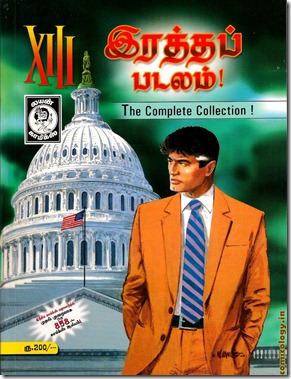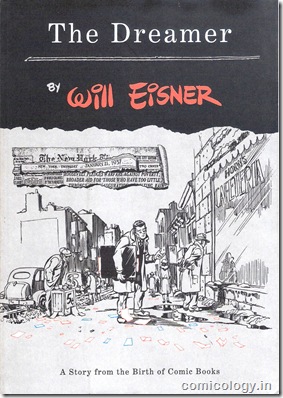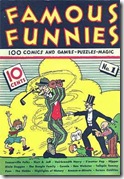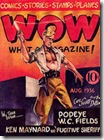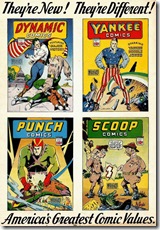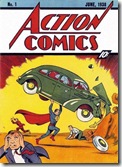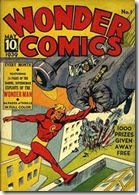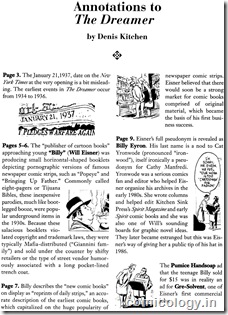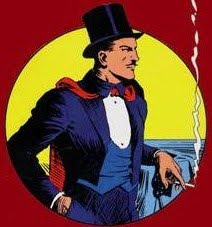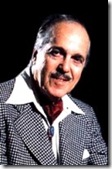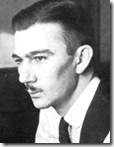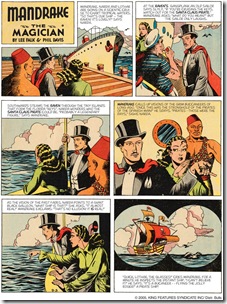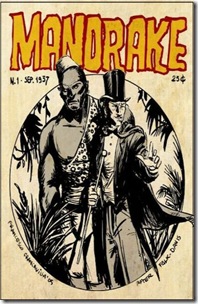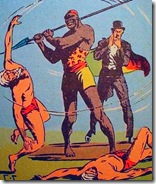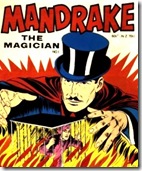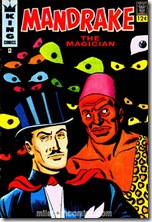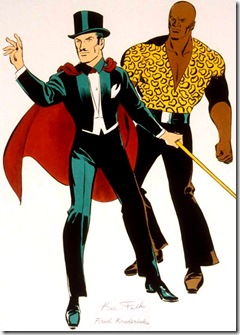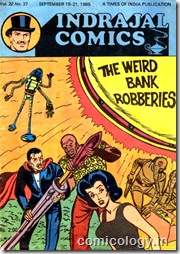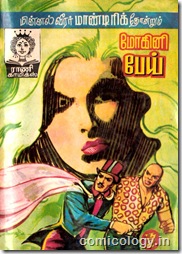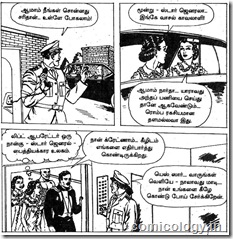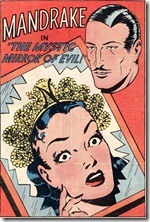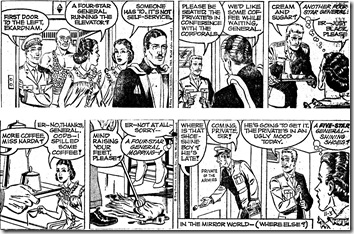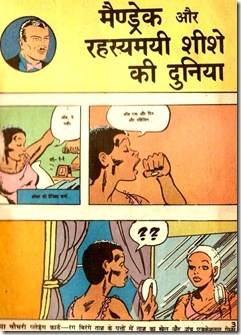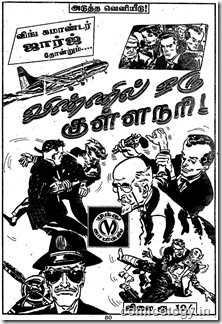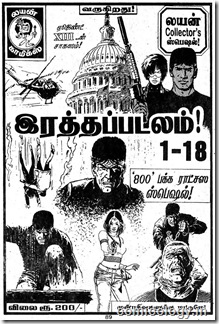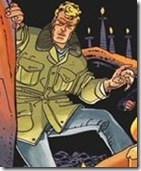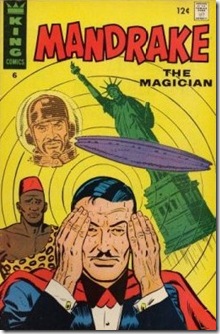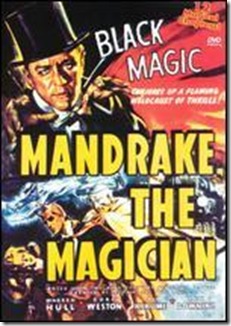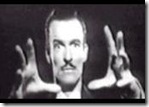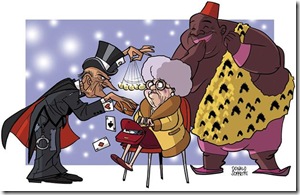During our recent comics news post, we had a look at a host of aspiring comics companies, trying to stake their claim in the 9th Art. When we can cherish their initiatives and contemporary art, the fact remains that you can’t help but remember the pioneers in the business, who had set the standards, against which these contemporaries are trying to base their efforts and further evolve their creations.
But have you ever wondered, what would have been the situation at a time when the Comics was not a true art to be reckoned with? How difficult it would have been 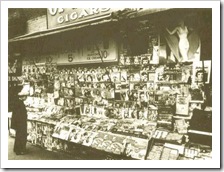 for the aspiring artists and writers, who struggled during these times to stake their claim, with the sheer intent of chasing their dreams? The answer lies on the birth of comics, which undoubtedly has its roots in the American Genre.
for the aspiring artists and writers, who struggled during these times to stake their claim, with the sheer intent of chasing their dreams? The answer lies on the birth of comics, which undoubtedly has its roots in the American Genre.
The blog post we have for this week is about a comic book, which takes us to this very moment, a time period which is often referred to, as the Birth of Comic Books. And who better to hear it from, then the man himself, the Godfather of American Comics, Will Eisner. Eisner was at the cradle of comics book birth, from its formations years through to its modernisation, in form of Graphic Novels, in the process creating a lot of First’s in the biz.
|
After graduation, Eisner joined the Art Students League of New York, where he eventually met his mentor, George Bridgman. Bridgman is credited for his long association with the art college spanning decades (attributed to have taught, a total of 70,000 students), where many budding artists who learned the trade, later went on to make their own mark in the industry. Bridgman who authored many a books in art, is still being widely read among artists fraternity. Bridgman’s teachings, coupled with the contacts he made at the Art school, was instrumental in Eisner becoming a commercial illustrator artist, for advertisement features and pulp magazines.for advertisement features, and as a page illustrator for then famous, pulp magazines. |
From then on, Eisner’s life story was a rollercoaster ride, where  from a contract page illustrator, he went on to setup an art studio of his own, only to leave that to start a new phase of his art life, in between being drafted to army,
from a contract page illustrator, he went on to setup an art studio of his own, only to leave that to start a new phase of his art life, in between being drafted to army, 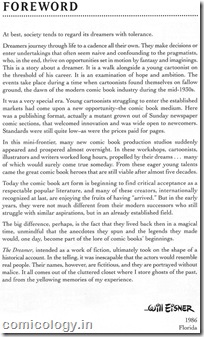 coming back to establish an art form, and eventually returning later to revolutionise it into its graphic novel level.
coming back to establish an art form, and eventually returning later to revolutionise it into its graphic novel level.
He had his larger than life presence, throughout the history of American comics, which spanned decades, garnering the hearts and respect among fans and writer/artists alike.
By 1986, Eisner had tried every other option in the field, that he decided to author a semi-autobiography in comics, The Dreamer, detailing his early years in the industry, when they sat up a comics studio in New York.
Instead of using real names, he built a disguise over each of the characters who appeared on the comics, which if you read deeply, would secretly refer to the famous personalities to have ever decorated the Comics form of the art.
Here is a foreword from the author himself, to read through his mind about this master-piece of historical significance.
Warning: The following is going to be a lengthy post. You bet, when we are talking about a historical artefact. :)
Let’s now look into the monumental comics, where we will halt at phases to introduce the real-life celebrities and events, who/which appeared in The Dreamer, sporting a Eisner inspired veil.
In keeping with the spirit, Eisner represents himself as the protagonist Billy Eyron, where the pseudonym is credited to a long time fan of Eisner, who eventually helped him set up his archives through his career, and went by the nickname, Yronwode. It was Eisner’s way of returning the favour.
 The year is 1937. Billy Eyron, an aspiring comic artist is walking the crowded streets of New York, where he stops before a Cafeteria, wondering whether he could spare his two dimes for wetting his sore throat. He decides eventually and enters the dine-in.
The year is 1937. Billy Eyron, an aspiring comic artist is walking the crowded streets of New York, where he stops before a Cafeteria, wondering whether he could spare his two dimes for wetting his sore throat. He decides eventually and enters the dine-in.
He meets a fortune teller, who in return for his 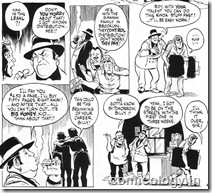 offer of a cup of coffee, foretells him to become a successful man in his career. Billy breaks to a laughter and walks out of the Cafeteria, lesser does he know what lies ahead of him, in his long journey.
offer of a cup of coffee, foretells him to become a successful man in his career. Billy breaks to a laughter and walks out of the Cafeteria, lesser does he know what lies ahead of him, in his long journey.
In between his search for work, Billy works as a Cleaner in a Printing press, where he is once approached by a strange looking man, who offers to provide him a contract, for drawing a series of cartoon books.
There is a catch though, as he is an underworld book publisher, who illegally 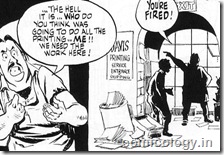 creates pornographic content over the popular copyrighted characters. Eventhough desperate to get some work, Billy didn’t want to add his portfolio, with the lowly art form,
creates pornographic content over the popular copyrighted characters. Eventhough desperate to get some work, Billy didn’t want to add his portfolio, with the lowly art form, 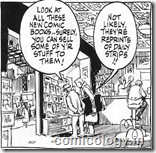 which was famous called as Tijuana Bibles.
which was famous called as Tijuana Bibles.
He decides to turn down the offer, and finds himself kicked out of his job, by an irate boss who dreamt of garnering the lucrative printing work of the new offering.
Billy’s dream is to create a comic book in its true essence, then the brand new so called comics which were available those times, merely carrying reprints of daily strips.
 Billy desperately tries to find a publisher for his works, who predominantly seem to refuse him for his ‘cartoonish' style of art, which differs from the art produced by the then the majority page contract illustrators.
Billy desperately tries to find a publisher for his works, who predominantly seem to refuse him for his ‘cartoonish' style of art, which differs from the art produced by the then the majority page contract illustrators.
In this passage, he meets his friend Ken Corn, to whom he showcases his first work as a commercial artist for an advertisement. To boost his morale, Ken takes him to a newly formed cartoonists association, where Billy  finds conflicting interests among the aspiring cartoonists, who demand for high pay rate from publishers, but without the union’s consent keep working for the low cost. Obviously, the want of food, is far more superior than mere community law.
finds conflicting interests among the aspiring cartoonists, who demand for high pay rate from publishers, but without the union’s consent keep working for the low cost. Obviously, the want of food, is far more superior than mere community law.
Eisner refers to his long-time friend, and legendary Batman creator, Bob Kane, as Ken in here.
Before he leaves the chaos union, Ken gives him a reference to seek an audience with the newly created cartoons magazine, SO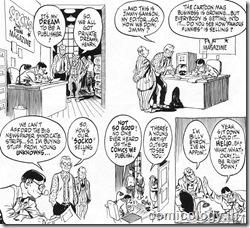 CKO, where he could possibly sell some of his work. Billy visits the office, and meets Jimmy Samson, who is at the helm of publishing, as the Editor.
CKO, where he could possibly sell some of his work. Billy visits the office, and meets Jimmy Samson, who is at the helm of publishing, as the Editor.
Before SOCKO, there was a famous comics magazine, which was doing its rounds in the comics industry called, Famous Funnies, which is rightly pointed by Samson in his reply to his publisher.
Famous Funnies, is a real magazine, which had a bigger backing, in the form
of Dell Publishing, and heavily depended on the reprints of copyrighted daily strip.
It had a successful run during that period, starting from 1934, piggybacking on famous syndicated comic strips, being published in host of newspapers around world.
The ownership of Famous Funnies changed multiple hands, and had numerous brand revisions, but it eventually managed to run for a total of 218 issues, thus inspiring a lot of initiatives in its shadows.
In comparison SOCKO, was a sidebar business run by a fabric businessman,  and thus had to rely heavily on newer content by unknown artists, to reduce cost. So, when Billy meets Jimmy, and helps him in a sudden emergency, he gets hired for a 4 page story on the magazine.
and thus had to rely heavily on newer content by unknown artists, to reduce cost. So, when Billy meets Jimmy, and helps him in a sudden emergency, he gets hired for a 4 page story on the magazine.
Billy works day and night to complete his first maiden venture, and just when he is about to complete the cores, he gets a call from Jimmy, detailing that SOCKO is closed down.
SOCKO, Jimmy, and SOCKO’s closing all are real. Eisner referred the short-lived Wow! What a
Magazine!, as SOCKO, and Jimmy was none other Samuel Jerry Iger, who later went onto to become a joint partner of Eisner’s art studio.
The only difference lies in the fact, where the comic book states that the deal was cut even before it materialized, wherein, in reality, Eisner was associated with a handful of comic series and even designed the covers of few WoW Magazines, before it was wrapped up with Issue #4, as said in the comic book too.
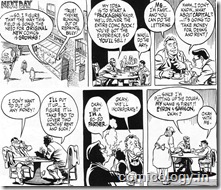 Billy, even though dejected, finally decides that he will chase his dream of creating all new content for comic books, by deciding to start his own comics business, with the marketing expertise of Jimmy. Both agree in principle and start the Eyron & Samson Studio.
Billy, even though dejected, finally decides that he will chase his dream of creating all new content for comic books, by deciding to start his own comics business, with the marketing expertise of Jimmy. Both agree in principle and start the Eyron & Samson Studio.
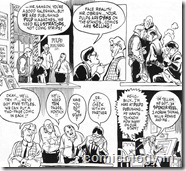 Jimmy with his marketing skills gets in the Pulp fiction publishers, Pulpo Co., to reserve them some space for the new age phenomena of comics, which they eventually agree, in order to arrest their falling sales.
Jimmy with his marketing skills gets in the Pulp fiction publishers, Pulpo Co., to reserve them some space for the new age phenomena of comics, which they eventually agree, in order to arrest their falling sales.
In order to project their studio as a place with more artists, Billy decides to change and alter his style, with different pseudonyms, to produce different comic series.
Eyron & Samson eventually refers to the joint venture art studio set by Eisner & Iger, which had its successful run from the 1936 to 1940’s, in the process supplying newly drawn comics content to a host of upcoming comics publications. Eisner was just 19, when he joined this venture, but he confesses that he claimed that he was 25, to get the consent of Iger. It is also true that, during the inception of the studio, Eisner did write and draw a host of comics series under different pseudonyms, to virtually bulk up their studio strength, in order to win more bids.
Eisner & Iger’s studio’s early success, was much credited to the period in which they started the business, a period what
many experts believed as the start of Golden Age of American Comics.
But, Pulpo Co., soon closes down, due to the decreasing sales and need of their books; and Eyron & Samson studio, are left to look for other aspiring comics publishers.
Pulpo Publishing Co. named by Eisner in here, actually refers to Fiction House, an American publisher of pulp comics, from 1920s to 1950s. They had a huge line-up of comics, mainly fed to them by the Eisner & Iger studios.
One of their famous comics ever, was Sheena, Queen of Jungle, created by Eisner himself, along with his partner Iger, under the pseudonym W. Morgan Thomas (one of his several ghost names to spike up their staff strength, virtually).
The scene shifts with the focus now diverted to the DH Printing Co., which is on the verge of making an  important decision, which goes a long way in shaping their future.
important decision, which goes a long way in shaping their future.
Donald Harrifield the president, and Jakob Lovecraft his deputy, are discussing their falling sales in pulp magazine distribution, and brainstorm 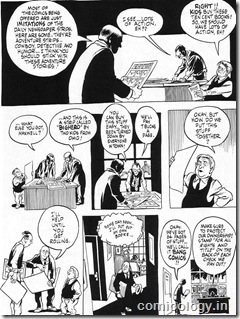 on an idea of publishing something different to keep their presses going.
on an idea of publishing something different to keep their presses going.
Jakob suggests that they go the Funnies way, and print some comic books. They identify Capt. Montrose B. Wilson, who owns small but loss making comics business, and as a result owes DH Co., some money in return. So, they decide to buy his comics business from him, and run it under their brand, which they eventually manage to do with little ease.
To help them build new comic series, they bring in a freelance agent, Chuck Maxwell, who provides them a series of original comics written and drawn by some young artists. Donald decides that kids love Action the most, and hence chooses that as the main theme for their new comics business.
Among the suggestions, Chuck also points that the Two kids from Ohio, have produced a series called Big Hero, which could be used for the new start-up. Chuck offers to help in setting up the new comics business for DH & Co., and Donald orders all the strips which they take in for publishing, be copyrighted to the company and not to the creators.
The repeated mention of Pulp magazines dying, is indeed true. The declining demand of the inexpensive fiction magazines and
sales, was instrumental in the Superhero comics business which took over the reigns later.
DH Printing Co., and its owner Donald Harrifield, eventually refers to Donny Press, and its owner
Harry Donenfeld, who were involved with Pulp magazines publishing in 1930s.Captain Montrose Wilson, refers to Major Malcom Wheeler-Nicholson who owned a comic book company
named National Allied Publication (they were the first recognized company to have printed original comics, instead of the daily strips reprint approach by other competitors), which was eventually forced out of him by Donenfeld, who assumed the company, and turned it to the one known as the legendary DC Comics today.
Chuck Maxwell was indeed Maxwell Gaines, who was the pioneer figure in the creation of modern comics, having brought many aspiring comics creators to world fame limelight. One of his most recognised contributions was bringing the Superman to DC Comics.
In the comics, Eisner refers to the same fact when Maxwell addresses it as Big Hero, and the two kids from Ohio, were indeed Jerry Siegel and Joe Shuster, who both lived in Cleveland, Ohio; and eventually sold their comic character to DC Comics, after being turned down by many publishing companies. Superman turned the fortunes around for DC Comics, eventually, and continue to do so even today.
As Donald points out in the end of the panel - “Stamp For All Rights on back of all Pay Checks”, all the leading comics publishing companies that time, published the new series with the contract of they owning the creator rights, thus turning many creators, to be just paid the fees for writing and drawing their own creations, while the DC Comics (and Marvel Comics later) raked in all the moolah, including Superman. One of the reasons why the short-lived Image Comics rose to immediate fame, which let the creators own the rights to their characters.
Maxwell also points out in the panel, that he will eventually start his own comics business, after having assisted and turning the fortunes of many aspiring comics
publishers. He eventually did start his own company, called Entertaining Comics (EC Comics), which among other, published one of the famous magazines Tales from the Crypt, and the long-running MAD. It is also ironic, that both Crypt and MAD were later absorbed by DC Comics themselves.
 With that historical account, the focus shifts back to Eyron & Samson studio, which has slowly found its foot, by syndicating content for various comics businesses. Suddenly Ken Corn who
With that historical account, the focus shifts back to Eyron & Samson studio, which has slowly found its foot, by syndicating content for various comics businesses. Suddenly Ken Corn who 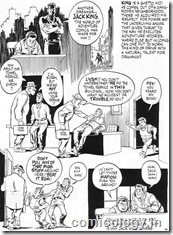 was freelancing for the studio, turns around to DH Printing Co., selling his Rodentman character to them.
was freelancing for the studio, turns around to DH Printing Co., selling his Rodentman character to them.
Understanding that the freelance assistance won’t help their fortunes, Eyron & Samson decide to hire artists and writers, for their own studio, which they eventually do.
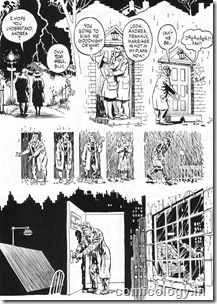 This brings in a whole lot of characters into the fold, building the studio with multi-focussed talents and creativity.
This brings in a whole lot of characters into the fold, building the studio with multi-focussed talents and creativity.
The following pages are devoted to the 
Billy also highlights that the artistic work in the Studio, was done like an Assembly plant, where the artists literally worked on the frames created by others, and passed on to the next inker or colourist in line.
Bob Kane (aka. Ken Corn in here), who was schoolmate of Eisner, refers to Batman, when he says Rodentman; which he eventually sold to DC Comics, where it became one of the two flagship characters, along with Superman.
Eisner refers to Jack “King” Kirby (the legendary co-creator of Captain America, Fantastic Four, Hulk, X-Men, and many others for Marvel Comics), with shortened name of Jack King in the story.
Armand Budd was Audrey “Toni” Blum, daughter of Alex Blum (who also worked as an illustrator in the studio). Budd was the only female in the Eisner & Iger Studio, and Eisner was quick to admit that he had a soft corner over her. Later on, Eisner re-iterated the stance he referred in the Comics, as All-work-and-no-play, as he felt these interest were unnecessary, when he was working towards establishing his career in the field.
Ms.Blum later married another studio inmate artist, Bill Bossert, and continued to be actively involved in studio works, as the script writer for many a stories produced, despite she lacking any formal experience on scripting cores.
Eisner’s recollection of the Assembly line in the Studio, was indeed true. They were the first art company, to have produced comic artwork in predesigned Layouts, were Eisner was at forefront.
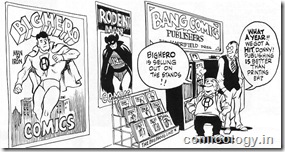 At Don Harrifield Press, the owner is on the moon as his two new comics on the market were hot-selling. One of those days, when his savvy accountant Vince Reynard, tries to advise Don on some business plans, Don in his typical aggressive style, asks him to mind his own business.
At Don Harrifield Press, the owner is on the moon as his two new comics on the market were hot-selling. One of those days, when his savvy accountant Vince Reynard, tries to advise Don on some business plans, Don in his typical aggressive style, asks him to mind his own business.
This irates Vince, who decides to leave the company and start his own comics business, 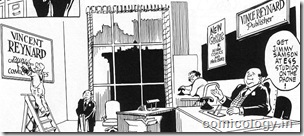 having seen the rise in the sales with the type of comics being printed in DH Press.
having seen the rise in the sales with the type of comics being printed in DH Press.
He eventually decides to copy the Big Hero concept and produce a similar character in the form of Heroman, and approaches the Eyron & Samson Studio for the works.
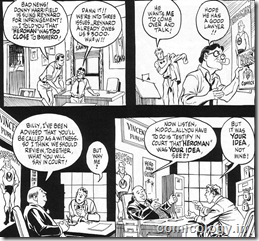 Billy is adamant on his policy of not infringing the copyright held by some other company, but the prospect of a big business, and with the insistence of Samson, he starts the work, with. Heroman #1 hitting the stands.
Billy is adamant on his policy of not infringing the copyright held by some other company, but the prospect of a big business, and with the insistence of Samson, he starts the work, with. Heroman #1 hitting the stands.
But as suspected, DH Press sues the Vincent Publishing, for copyright infringement of their Big Hero character into Heroman. Vincent puts an ultimatum to Billy, to testify in court that Heroman was Billy’s own idea. Failing which, he threatens to hold the big payment which is pending from Vincent Publishing to his Studio.
Despite the prospect of losing out the big money, Billy decides to live by the truth in the court, which puts Vincent’s Heroman comics to cold storage, and Billy incurring a huge loss as unrecovered debt for his studio from Vincent.
As it is evident, Superman (Big Hero) and Batman (Rodentman) were indeed selling out on stands during the early time of DC Comics, when it was known as National Periodical Publications. This prompted Victor Fox (identified as Vincent Reynard in Eisner’s Dreamer), who was working as an accountant under DC Comics, to start his own business -
Fox Feature Syndicates, and imitate Superman in his own form as Wonder Man.Eisner indeed was the artist for the first issue, after which DC Comics, filed a suit (the first ever recorded, in Comics Industry), and put Wonder Man out of print. Eisner, later pointed out that despite the big money in offer, he was not going to hide the truth in the court, which went in a long way in deciding the case against Victor Fox, a fact highlighted in this comic too.
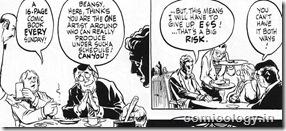 Eyron & Samson Studios, grows from strength to strength, when one day Billy Eyron is approached by some newspaper agents, who would like to introduce a new concept in the newspapers to counter the competition raised by Comic Books.
Eyron & Samson Studios, grows from strength to strength, when one day Billy Eyron is approached by some newspaper agents, who would like to introduce a new concept in the newspapers to counter the competition raised by Comic Books.
They plan to introduce a 16 page Comics supplement, and 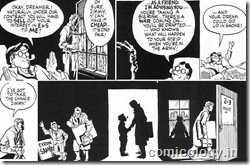 believe Billy is the right man to do the job, with the importance of feeding to the increased weekly demand for new materials, which they believe only Billy could manage to do so, given his track records.
believe Billy is the right man to do the job, with the importance of feeding to the increased weekly demand for new materials, which they believe only Billy could manage to do so, given his track records.
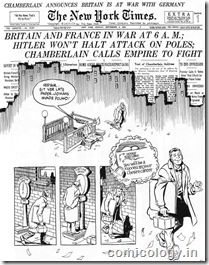 Billy’s dream was always to enter the Adult audience, for which he believes that Newspaper’s would offer the perfect platform. This meant that he was to leave his 3 year long high paying association and partnership with the Studio.
Billy’s dream was always to enter the Adult audience, for which he believes that Newspaper’s would offer the perfect platform. This meant that he was to leave his 3 year long high paying association and partnership with the Studio.
After a long thought, Billy decides to chase his dream, and sells his part ownership to Jimmy, and leaves for finding newer horizons.
The comic book closes with the World War looming on the allied nations, and Billy confidently walking out to realize his dream, leaving the readers to imagine where his future will lead him to.
Eisner indeed left the 3 year old association with the Eisner & Iger Studios, in order to chase his long-time dream of reaching the Adults audience, as the Comic books which they were selling were mostly aimed at Kids and Teens. This meant Eisner had to sell of his part in the studio to Jerry Iger, for $20,000 in late 1939.
It’s also said that the main reason why Eisner left the ownership was that he wasn’t getting along well with Iger. He saw this as an perfect opportunity to break free and have his own career path.
Eisner made sure that in The Dreamer, he brought in every account of his involvement with Eisner & Iger Studios, with the intimate account of the important personalities who shared his life during the phase, along with detailing his failures, heart-breaks, and eventual success moments.
Eisner’s artwork had a cartoonish look, but yet was able to put the seriousness of the comic book at par with the readers. His greatest talent to bring art into a real-life moment, with inking and shades was unmatched. Despite being Black and White, the crayoned layed frames, were far more contemporary than any other colored artwork which was present then and now.
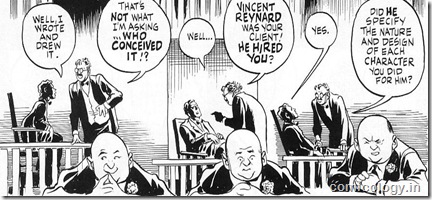 He was able to showcase the moods of the characters in phases, with small amount of ease, like in the case of the Court ruling. Look at the face reaction of Victor Fox (Vincent Reynard in the Comic) during the trial.
He was able to showcase the moods of the characters in phases, with small amount of ease, like in the case of the Court ruling. Look at the face reaction of Victor Fox (Vincent Reynard in the Comic) during the trial.
He simply was a master at his work. He even was at his humorous best to describe, some funnier moments in The Dreamer, which otherwise retells the serious comics history, which Eisner himself called as Leaden Age of Comics, contrary to the Golden Age of Comics coined by industry experts.
Some of the Sweeter moments as detailed in The Dreamer, is when
- he agrees to pay the bill during their first business meet with Jimmy, and spends his pocket; only to get scolded by Jimmy that he didn’t pay the tips;
- he overhears a conversation across the wall, and decides to bet on a horse; which he loses eventually
- he thinks that he fell in love with the lady he met in a party last night and shared the bed; only to see her send a check for her night services to his office.
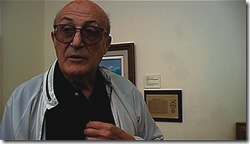 The great icon continued to script and entice the comics lovers all over the world, until his eventual death in 2005, due to a complexity resulted in a bypass heart surgery.
The great icon continued to script and entice the comics lovers all over the world, until his eventual death in 2005, due to a complexity resulted in a bypass heart surgery.
The comics world remembers his contribution by creating a Eisner Awards in 1988, which is considered as the best recognition among Comics fraternity,continuing till date. Eisner eagerly participated in all the awards ceremony all through his life until his death.
He continues to live in the mind of all comics lovers.
 Book Facts: The Dreamer was originally published in 1986, by DC
Book Facts: The Dreamer was originally published in 1986, by DC 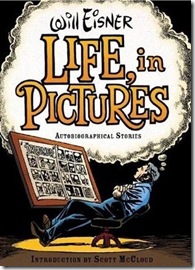 Comics, under the brand of Will Eisner Library.
Comics, under the brand of Will Eisner Library.
It was later taken over by Will Eisner Estates, along with other contributions of his in the Comics and Graphics Novels genre.
The Dreamer was then included, along with some of Eisner’s autobiographical work, as the Life in Pictures, which carried an introduction by Scott McCloud, who often refers to Eisner as the inspiration for his own self.
In 2007, Denis Kitchen, wrote a wonderfully detailed annotation, to accompany the book, where he explained over the lightly disguised characters in the story, with historical fact and accuracy.
The events taking place in the comic book is detailed as it to have happened between 1937 to 1938, but in fact, much of the early incidents is attributed to the years 1934 to 1936, as per Kitchen.
 This blog post at Comicology, owes much to the Annotation of Denis Kitchen, which helped to gather the necessary information and collate a tributary post to the Godfather of American Comics, Will Eisner.
This blog post at Comicology, owes much to the Annotation of Denis Kitchen, which helped to gather the necessary information and collate a tributary post to the Godfather of American Comics, Will Eisner.
In 2008, WW Norton Company, started a new series of Eisner books, reprinting the classics in a newer and better format.
The book which is used for this review is from a copy in the Norton set, which eventually carried the Annotations by Denis Kitchen.
The copy is readily available on leading stores across India, along with other wonderful titles of Will Eisner.
What was shared in this blog post was only a tip of the wealth of information available on The Dreamer. So, if you get a chance, don’t miss out from owning this wonderful comic in your collection.
Eisner’s Other Works: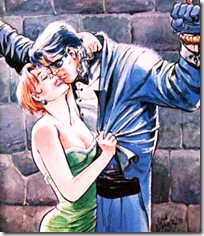 Before we close, if anyone still doesn’t get a clue on what Newspaper Comic section, which Eisner eventually went to work for?… it is indeed the path-breaking, The Spirit.
Before we close, if anyone still doesn’t get a clue on what Newspaper Comic section, which Eisner eventually went to work for?… it is indeed the path-breaking, The Spirit.
Eisner brought comics to the next level, by popularising it widely among adults and teens at the same time, and it still stands to immortalize Eisner for centuries to come.
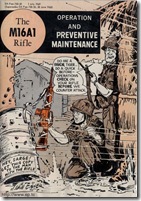 The Spirit also came to the fore by revolutionizing the widely popular Comics Sections, which was a prominent Sunday newspaper feature in late 19th century.
The Spirit also came to the fore by revolutionizing the widely popular Comics Sections, which was a prominent Sunday newspaper feature in late 19th century.
His Studio business partner, Iger’s advise that the War may put his newspaper comics to rest, was also true, as Eisner was drafted in to the War, but instead found a job to his liking, producing some comics work for the Army themselves.
He later returned, and continued his great work on The Spirit, with interesting twists and scripts for over a decade, which mesmerised, the newspaper readers, and brought many fans of all ages, to the comics medium.
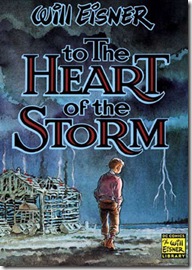
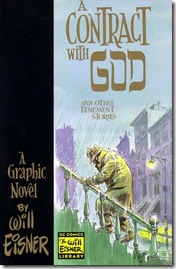 In 1978, Eisner came back with his first Graphic Novel, a term which he helped to popularize, with A Contract with God. It was a path-breaking issue, which is still considered as the pioneer of Graphic Novel.
In 1978, Eisner came back with his first Graphic Novel, a term which he helped to popularize, with A Contract with God. It was a path-breaking issue, which is still considered as the pioneer of Graphic Novel.
In 1991, Eisner wrote one another critically acclaimed autobiography, where he reflected over the war times in his perspective, in To The Heart Of The Storm.
We can go on and on with detailing all his work, which definitely may not get over in one post. So, we will leave it for another day. :)
That brings us to close of this lengthy post at Comicology, which I enjoyed bringing to all of you. The knowledge I gained while working on this post about the Golden Age of American Comics, made me realize how difficult it would have been for those who aspired to set the business in its early form, and understand the true essence of the Comics, as it is today. I hope that the readers of this post, would share the same feeling. Adios Amigos !!
References: Will Eisner’s Official Site, Eisner’s Biography on Official Site, Wikipedia on Will Eisner, Eisner’s Lambiek Profile, The Dreamer’s Annotations by Denis Kitchen



